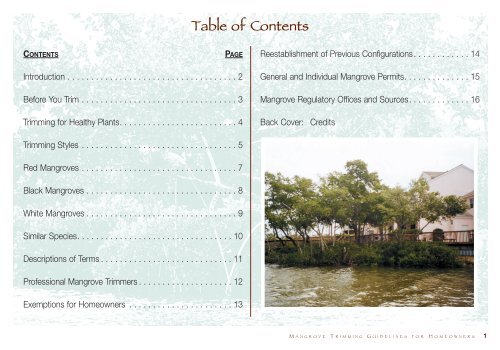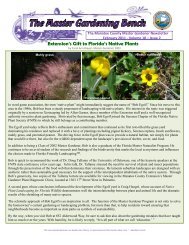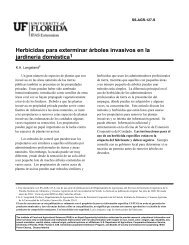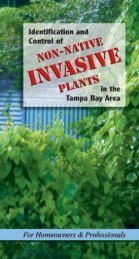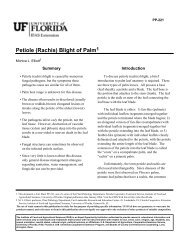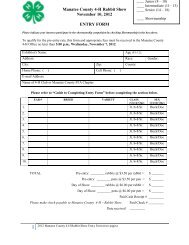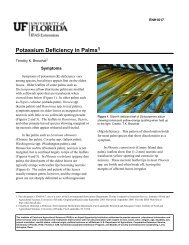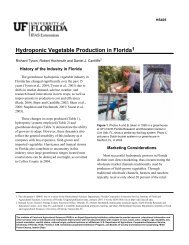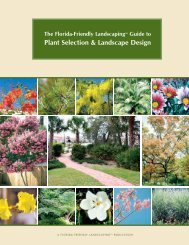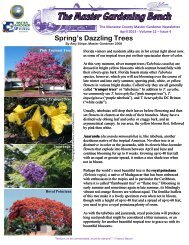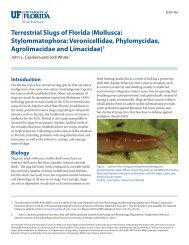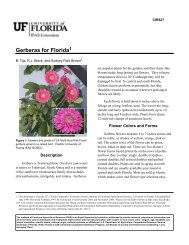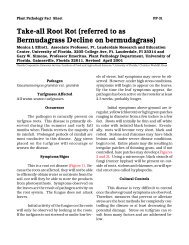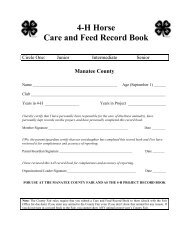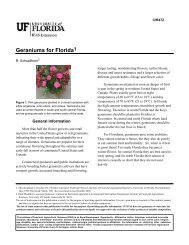Mangrove Trimming Guidelines - Manatee County Extension Office
Mangrove Trimming Guidelines - Manatee County Extension Office
Mangrove Trimming Guidelines - Manatee County Extension Office
You also want an ePaper? Increase the reach of your titles
YUMPU automatically turns print PDFs into web optimized ePapers that Google loves.
CONTENTS PAGE<br />
Introduction . . . . . . . . . . . . . . . . . . . . . . . . . . . . . . . . . . . . 2<br />
Before You Trim . . . . . . . . . . . . . . . . . . . . . . . . . . . . . . . . . 3<br />
<strong>Trimming</strong> for Healthy Plants. . . . . . . . . . . . . . . . . . . . . . . . . 4<br />
<strong>Trimming</strong> Styles . . . . . . . . . . . . . . . . . . . . . . . . . . . . . . . . . 5<br />
Red <strong>Mangrove</strong>s . . . . . . . . . . . . . . . . . . . . . . . . . . . . . . . . . 7<br />
Black <strong>Mangrove</strong>s . . . . . . . . . . . . . . . . . . . . . . . . . . . . . . . . 8<br />
White <strong>Mangrove</strong>s . . . . . . . . . . . . . . . . . . . . . . . . . . . . . . . . 9<br />
Similar Species. . . . . . . . . . . . . . . . . . . . . . . . . . . . . . . . . 10<br />
Descriptions of Terms . . . . . . . . . . . . . . . . . . . . . . . . . . . . 11<br />
Professional <strong>Mangrove</strong> Trimmers . . . . . . . . . . . . . . . . . . . . 12<br />
Exemptions for Homeowners . . . . . . . . . . . . . . . . . . . . . . 13<br />
Table of Contents<br />
Reestablishment of Previous Configurations . . . . . . . . . . . . 14<br />
General and Individual <strong>Mangrove</strong> Permits. . . . . . . . . . . . . . 15<br />
<strong>Mangrove</strong> Regulatory <strong>Office</strong>s and Sources. . . . . . . . . . . . . 16<br />
Back Cover: Credits<br />
M ANGROVE T RIMMING G UIDELINES FOR H OMEOWNERS 1
T<br />
his booklet is intended to assist coastal property owners in identifying, trimming,<br />
and altering mangrove trees in a manner that will:<br />
• provide a view of the water<br />
• protect valuable mangrove resources; and<br />
• be in compliance with state laws that regulate the trimming and alteration of<br />
mangroves.<br />
<strong>Mangrove</strong>s are tropical trees that are restricted to the calm intertidal areas of<br />
Florida where temperatures do not usually drop below freezing for prolonged<br />
periods. They generally exist south of St. Augustine on the east coast and from<br />
Cedar Key south on the West Coast.<br />
There are three species of mangroves in Florida: red, black, and white. They are<br />
generally not found in freshwater systems due to competition with other species,<br />
and other factors. Because each species responds differently to trimming,<br />
information on the identification of these species is provided in pages 7 through 10<br />
of this booklet.<br />
<strong>Mangrove</strong>s provide many benefits to us and our environment:<br />
• Their roots and trunks resist and prevent shoreline erosion;<br />
• They provide food and habitat for the marine food chain, including fish we like to<br />
catch and eat;<br />
• They assist with maintaining and improving the quality of our coastal waters;<br />
and<br />
• They can protect homes from severe wind damage.<br />
<strong>Mangrove</strong>s can grow rapidly and often form dense thickets that block the view of<br />
the water for waterfront property owners. For this reason, many property owners<br />
have already cut their mangroves to improve their view of the water, and many more<br />
would like to cut mangroves to get a view they do not currently enjoy. Unfortunately,<br />
some cutting of mangroves has not been done in conformance with all applicable<br />
state and local regulations. If not done properly, trimming can harm or kill<br />
2 F LORIDA D EPARTMENT OF E NVIRONMENTAL P ROTECTION<br />
Introduction<br />
mangroves. While this might maximize a view of the water, many people do not<br />
realize that killing or harming mangroves can have many unintended adverse<br />
consequences to the benefits mangroves provide. The Florida Marine Research<br />
Institute has reported an 86% loss of mangroves in Florida since the 1940’s. With<br />
this has been a loss in the productivity and quality of many of our nearshore<br />
waters.<br />
The Florida Legislature enacted the 1996 <strong>Mangrove</strong> <strong>Trimming</strong> and Preservation Act<br />
(1996 Act) in sections 403.9321-403.9334 of the Florida Statutes (F.S.). This law<br />
regulates the trimming and alteration of mangroves statewide, including at the local<br />
level. A copy of the 1996 Act can be obtained from agency sources listed at the<br />
end of this booklet. While the 1996 Act does recognize a riparian right to view in the<br />
intent section (ss.403.9323, F.S.), there are instances when waterfront property<br />
owners may not be able to legally obtain a view or all the view they desire.
S<br />
horeline owners have a unique opportunity to directly participate in the<br />
stewardship of Florida’s marine environment by understanding that there are many<br />
ways that a reasonable view of the water may be obtained without severely injuring<br />
or killing mangroves. By so doing, portions of mangroves that are not cut can<br />
remain healthy and continue to provide valuable benefits to our coastal waters.<br />
Regulations: The heights to which a mangrove tree may be trimmed depends upon<br />
the species and condition of the tree, and the provisions of the 1996 Act.<br />
<strong>Mangrove</strong>s may not be trimmed lower than 6 feet in height from the substrate<br />
(ground surface) under the exemptions and general<br />
permits in the 1996 Act, except for certain<br />
maintenance trimming of historically established<br />
configurations. Large trees may have to be reduced<br />
in height in stages over several years, and often<br />
trees cannot be trimmed as low as 6 feet. In no<br />
case may trimming result in defoliation (loss of the<br />
tree’s leaves), destruction (death of a part or all of<br />
the tree), or removal of a mangrove. Actions that<br />
result in the defoliation, destruction, or removal of a<br />
mangrove are considered “alteration,” (not<br />
“trimming”) and are regulated through individual<br />
permits. The right to trim mangroves is only<br />
provided to riparian owners (see Page 11,<br />
Description of Terms). Both the property owner and the person hired by the property<br />
owner to do the trimming should understand the 1996 Act and applicable local<br />
regulations, because both the property owner and the person performing the<br />
trimming are jointly and severally responsible for complying with the 1996 Act.<br />
Chapters 373 and 403, F.S., contain separate provisions for cutting mangroves in<br />
order to conduct activities authorized under the wetland resource and environmental<br />
resource permit programs. <strong>Mangrove</strong>s located within the footprint of an activity so<br />
authorized do not require a separate authorization under the 1996 Act. However,<br />
future trimming of mangroves to enjoy the view attained by a structure so authorized<br />
would be regulated under the 1996 Act.<br />
Before You Trim<br />
Professional <strong>Mangrove</strong> Trimmers (PMTs): The 1996 Act has provisions (section<br />
403.9329(1) and (2), F.S.) for qualifying certain persons as PMTs. These persons are<br />
required to supervise or conduct certain types of trimming, and typically are the<br />
best qualified to do most trimming in a manner that is least damaging to the trees.<br />
Pages 12 through 14 of this pamphlet provide additional information on the use of<br />
PMTs.<br />
Conducting trimming without professional experience: Shoreline owners may<br />
trim mangroves themselves where previously untrimmed trees are between 6 and<br />
10 feet in height, and where trimming is needed to<br />
maintain a previously trimmed configuration.<br />
However, such maintenance trimming is limited to<br />
situations where the mangroves have not grown so<br />
tall and dense that a view of the water has been<br />
blocked for a prolonged duration. Except for trees<br />
10 feet or less in height, reestablishment of a<br />
previous configuration requires a PMT. Regardless<br />
of who conducts the trimming, contact your county<br />
<strong>Extension</strong> Service office or the International Society<br />
for Arboriculture (http://www.floridaisa.org) for<br />
additional information on standard horticultural<br />
practices. There also are some excellent and easy<br />
to read books available from libraries, bookstores,<br />
and the internet for this purpose. Remember, you are responsible for trimming<br />
mangroves in accordance with the 1996 Act. (Refer to Page 4, <strong>Trimming</strong> for<br />
Healthy Plants, and Pages 5-6, <strong>Trimming</strong> Styles.)<br />
Styles of trimming: <strong>Mangrove</strong>s can be trimmed in a variety of ways that can<br />
provide a view while still protecting the health of the tree. A PMT, your <strong>County</strong><br />
<strong>Extension</strong> Service, libraries, and many web sites can provide additional information<br />
on standard horticultural practices. However, in all cases, the trimming must be<br />
done in a manner that will not cause the defoliation, destruction, or removal of the<br />
mangrove. Suggested alternative trimming techniques are provided on Pages 5-6,<br />
<strong>Trimming</strong> Styles.<br />
M ANGROVE T RIMMING G UIDELINES FOR H OMEOWNERS 3
H<br />
ealthy mangroves are more beneficial to your shoreline, to the fisheries,<br />
to our water quality, and to your landscape design than are mangroves that<br />
have been trimmed improperly.<br />
<strong>Trimming</strong> (many publications also may refer to this as “pruning”)<br />
Objective - When trimming a branch, the desired result is a nice, clean cut<br />
to the branch side of the juncture of the branch and the limb (or trunk).<br />
Damage to that junction will wound the tree. Stubs left on the tree are<br />
subject to decay, and may be a source for future insect and fungal damage.<br />
Equipment - Tools must be clean and free of oils. It is important that the<br />
tools are sharp for a clean cut. The wood at the cut should be smooth, not<br />
frayed. Frayed cuts may not heal properly and may be a source of infection.<br />
If fraying occurs, your trimmer’s tools may not be sufficiently sharp. Do not<br />
use pesticides or pruning paint on any cuts.<br />
Timing - <strong>Trimming</strong> is best done during the months of October through<br />
March, when mangroves are not growing as vigorously and energy demand<br />
for producing propagules is reduced. However, this is also the time when<br />
mangroves may be damaged or killed by freezes. It is recommended that<br />
mangroves not be trimmed for at least six months following a freeze in order<br />
to allow time to determine what portions of the tree may have actually been<br />
affected by the freeze. Removal of dead and freeze-damaged portions of a<br />
tree is a good horticultural practice after that six-month period. In addition,<br />
once mangroves have been trimmed, it is a good idea to maintain that<br />
configuration through regular (i.e. six-month to one-year intervals)<br />
maintenance trimming. This maintenance should only cut back to the<br />
previous configuration. Regular trimming will reduce stress to the tree in the<br />
future and will maintain a view of the water.<br />
Procedure - To obtain the preferred cut without the weight of the branching<br />
causing the wood to tear, follow the procedures at right.<br />
4 F LORIDA D EPARTMENT OF E NVIRONMENTAL P ROTECTION<br />
<strong>Trimming</strong> for Healthy Plants<br />
Defoliation is stressful. If all or most of the leaves are trimmed off of a<br />
mangrove, its survivability is severely reduced. Red mangroves and large black<br />
mangroves are most susceptible to death from defoliation. To prevent this from<br />
happening, it is recommended that no more than 25% of the foliage is removed<br />
annually. It is also recommended that the upper 50% of the canopy of red<br />
mangroves not be cut (i.e., no top trimming of red mangroves). The upper canopy<br />
of old, mature black mangroves also should not be removed.<br />
Refer to pruning guides available from county extension agents, the<br />
International Society of Arboriculture (http://www.floridaisa.com) and<br />
bookstores for further details.<br />
Cut out and away<br />
from the larger<br />
limb or trunk<br />
Branches less than<br />
1/2 inch.<br />
Final appearance.<br />
1st cut<br />
Branches greater than<br />
1 inch. (use three cuts)<br />
Stem after trimming<br />
2nd cut<br />
FINAL CUT
T<br />
here are several styles of trimming that can provide a pleasing view of the water.<br />
While hedging is the form most commonly used, it often is the most<br />
environmentally damaging. Other alternate styles can provide a view in a manner<br />
that is less stressful to the mangroves and may require less maintenance.<br />
Windows: A view<br />
through large trees can<br />
be obtained by selective<br />
limb removal within the<br />
lower or central area of<br />
the tree. Windowing<br />
allows for a view while<br />
maintaining shade,<br />
privacy, a windbreak and<br />
additional habitat for<br />
wildlife.<br />
Hedging: <strong>Trimming</strong> mangroves into the hedged shape provides a view across the<br />
top of the mangroves. If all of the leaves of a tree are in the upper canopy and<br />
trimming the canopy will<br />
remove all of the leaves,<br />
then the top trimming<br />
activity of hedging may<br />
not be performed or<br />
only performed to the<br />
height that does not<br />
defoliate or otherwise<br />
damage the tree.<br />
Hedging is not<br />
recommended for red<br />
mangroves or for mature<br />
black mangroves. <strong>Trimming</strong> to form a hedge generally cannot be performed to<br />
heights of less than 6 ft. unless the property has a previously, legally established<br />
trimming configuration to a lower height and the agency has reviewed and<br />
<strong>Trimming</strong> Styles<br />
approved documentation of the historic configuration. (see Page 14<br />
Reestablishment of Previous Configurations).<br />
Undercutting: This is the trimming of the lower portion of a tree. Undercutting as it<br />
is sometimes called, may provide a view lower than 6 feet through a taller tree but<br />
young plants that grow up through that viewing area can not be trimmed until they<br />
exceed 6 feet. The results will be similar to window trims with a lower view at 6<br />
feet. Recruiting young plants (those colonizing under established trees) also should<br />
not be pulled out of the ground. This activity technically is a form of alteration and<br />
requires a permit.<br />
Whatever style of trimming you choose, consider a style that can be maintained<br />
with the least loss of leaves resulting from the trimming activity. <strong>Mangrove</strong> leaves<br />
are an important source of nutrients for the smaller animals of the marine food<br />
chain, including sea grass and coral reef communities. Leaves that die naturally<br />
on the tree and then fall into the water are much more quickly biodegraded and<br />
available as a food source than healthy leaves cut from the tree. Fresh cut green<br />
leaves will stay mostly intact lying on the substrate for months before total leaf<br />
breakdown.<br />
M ANGROVE T RIMMING G UIDELINES FOR H OMEOWNERS 5
D<br />
esign for a view and landscape that is comfortable for you while considering the benefits mangroves provide to your home and property. Refer to individual species<br />
discussions for additional trimming information.<br />
A combination of windowing and other landscape plants gives this home a<br />
beautiful and lush appearance with a view of their front walkway.<br />
If you are fortunate to have mangroves growing along your seawall or rip rap,<br />
the lush green vegetation provides a pleasing contrast to the cement and rock<br />
structures.<br />
6 F LORIDA D EPARTMENT OF E NVIRONMENTAL P ROTECTION<br />
<strong>Trimming</strong> Styles - continued<br />
These homeowners have decided to let their mangroves grow naturally. A small<br />
path through the mangroves provides access to their dock and pier.<br />
This two-story house, under construction, has a view of the water from various<br />
rooms of the house and still retains privacy from passing boaters.
R<br />
ed mangroves (Rhizophora mangle) are characterized by their arching prop<br />
roots. These roots, referred to as “aerial roots” before they enter the water,<br />
extend from the main trunk and lateral branches and grow down towards the<br />
water until they reach the substrate. Once in the substrate, the roots are<br />
referred to as “prop roots.” These prop roots provide support to the weight of<br />
the tree and assist in nutrient uptake and salt exclusion. Their leaves are<br />
elliptical, glossy and dark green on top, and paler, dull green, often with small<br />
black spots, underneath.<br />
Red mangroves tend to grow closest to the water. They are very valuable in<br />
preventing erosion of coastal properties because their prop roots, and smaller<br />
roots growing from them, help stabilize the shifting substrate of shorelines.<br />
Propagules hanging from red mangrove<br />
Red <strong>Mangrove</strong>s<br />
named after the color inside the bark<br />
The intertwined habitat of the roots provides shelter for juvenile and smaller<br />
species of fish and other marine organisms. Red mangroves are the most<br />
susceptible of the mangroves to damage from severe trimming. Cutting of the<br />
aerial/prop roots is prohibited without authorization from the agency. Red<br />
mangroves only grow from the end of their stems. This area is called the “apical<br />
meristem,” (growing tips on branches and main stems). When all of the leaves<br />
and the apical meristems are removed, their survival is very doubtful. This is why<br />
topping of red mangroves can be so damaging. These trees are best cut by<br />
trimming no more than 50% of the lower part of the canopy to form windows.<br />
Propagules are red mangrove seedlings that “start growth” within the wall of the<br />
fruit. They continue to grow and sprout while floating on the water. As the tip<br />
of the propagule gets saturated with water, it becomes heavy, falls toward the<br />
substrate, and sends out roots that establish in the substrate.<br />
Front cover photo: Ibis on a red mangrove.<br />
(above) Red mangrove – note extensive<br />
prop roots<br />
(left) Leaves and young propagules of red<br />
mangrove<br />
M ANGROVE T RIMMING G UIDELINES FOR H OMEOWNERS 7
B<br />
lack mangroves (Avicennia germinans) are distinguished by leaves that are<br />
dull, dark green on the upper side and whitish green/gray underneath. The leaves<br />
aid in salt exchange, which is why they often have a salty encrustation on the<br />
underside. They also possess pencil-like roots, called pneumatophores, that grow<br />
up from the sediments (like soda straws) for several feet from the base of the tree.<br />
The pneumatophores grow off of extensive cable roots running just under the<br />
surface of the soil. The pneumatophores are similar to the prop roots of the red<br />
mangrove in that they aid in air, nutrient, and salt exchange.<br />
Black mangroves can grow to be quite tall, usually with a singe main trunk that<br />
often has a large diameter in older trees. They are useful as windbreaks during<br />
severe weather. They are most attractive when the lower branches are trimmed<br />
(windowed) and the upper canopy is left intact or thinned. Their form, color and<br />
slender leaves often allow a pleasing, and somewhat private view from waterfront<br />
homes.<br />
Black mangrove<br />
propagules are smaller<br />
than red mangrove<br />
propagules and gray.<br />
They lay stranded by the<br />
tides until the fruit wall<br />
falls from the developing<br />
seedling, as the seedling<br />
sends small roots into<br />
the substrate. Black<br />
mangroves are generally<br />
able to grow in more<br />
saline and “basin like”<br />
conditions than the other<br />
mangroves.<br />
8 F LORIDA D EPARTMENT OF E NVIRONMENTAL P ROTECTION<br />
Black <strong>Mangrove</strong>s<br />
named after their dark bark<br />
(above) Window views under black<br />
mangrove canopy<br />
(left) Leaves and fruits (propagules)<br />
of black mangrove<br />
(above) Window view through a<br />
canopy of a black mangrove<br />
(left) Pneumatophores are primary<br />
characteristics of black mangroves
W<br />
hite mangroves (Laguncularia racemosa) are characterized by leaves that are<br />
uniformly light green on both their upper and lower surfaces. The leaves typically<br />
have small “notches” (indentations) at their tips, and two small” bumps” on<br />
opposite sides at the base of the leaf stem. The bumps are sugar secreting<br />
glands called “nectaries” that are thought to attract ants which aide in the control<br />
of other small plant-eating insects. White mangroves generally do not tolerate the<br />
same extent of flooding that black and red mangroves can tolerate. On rare<br />
occasions they produce pneumathoid roots around the base of the tree, but<br />
usually they are characterized by a single trunk without any other distinguishing<br />
features in the sediments surrounding the tree trunk.<br />
As the fruits are stranded on exposed substrate the fruit wall becomes spongy<br />
and the seedlings emerge .<br />
Of all Florida’s mangroves, the white mangrove is the most tolerant of trimming,<br />
including hedging. The wood of the white mangroves is not as strong as the black<br />
mangrove and they do not have the supporting prop roots associated with<br />
red mangroves. <strong>Trimming</strong> that removes all of the understory and lateral branches<br />
while retaining only a canopy can produce a “lollipop” trunk that often, in time, will<br />
bend and break. When trimming white mangroves, trim for balance of their<br />
weight as well as how they look.<br />
White <strong>Mangrove</strong>s<br />
named after the whitish bark<br />
(above) White mangrove<br />
tree with two trunks and<br />
a balanced canopy over<br />
a mostly white mangrove<br />
hedge<br />
(left) White mangrove<br />
leaves and fruits<br />
(right) White mangrove<br />
flowers just opening<br />
M ANGROVE T RIMMING G UIDELINES FOR H OMEOWNERS 9
Similar Species – Buttonwood & Brazilian Pepper<br />
Buttonwood - Conocarpus erectus<br />
Brazilian pepper – Schinus terebinthefolius<br />
Although<br />
buttonwood typically grows in close association with mangroves<br />
and is often referred to as a mangrove, it is not a true mangrove, and is not Brazilian<br />
pepper is an exotic shrub with dark green compound leaves (several<br />
protected or regulated by the 1996 Act. Buttonwood is protected bs some local portions to the leaf blade; as contrasted to mangroves that have simple leaves<br />
government ordinances. Buttonwood has two forms. The most common has with only one apparent blade). The leaves and wood are aromatic when crushed<br />
leaves that are similar to black mangrove leaves in shape, although they are or cut. Brazilian pepper also<br />
uniform green on the upper and lower surfaces. The rarer variety has leaves is distinguished by having<br />
that are silvery green on both sides. This later form is often used in<br />
clusters of bright red berries.<br />
landscaping. They do not have any prop roots or pneumatophores. The color The leaves can be irritating to<br />
of the leaves, the absence of large obvious root structures, and the angles that some people, and the berries<br />
are apparent on most of the stems distinguish buttonwood from<br />
can be toxic to wildlife.<br />
the three mangroves.<br />
Pepper grows very dense,<br />
with branches that are often<br />
intertwined and difficult to<br />
penetrate. Brazilian pepper<br />
also grows rapidly, typically<br />
crowding out other species<br />
of plants, and blocking views.<br />
Brazilian pepper typically<br />
grows immediately behind<br />
and within the landward edge<br />
of mangroves. When<br />
removing Brazilian pepper<br />
plants from the mangrove<br />
area, care must be taken not<br />
to cause destruction to the<br />
mangroves. Because<br />
Brazilian pepper is<br />
considered a nuisance<br />
exotic, homeowners are<br />
encouraged to completely<br />
Buttonwood Brazilian Pepper<br />
10 F LORIDA D EPARTMENT OF E NVIRONMENTAL P ROTECTION
A<br />
lter - Any human-induced removal, defoliation, or destruction of<br />
mangroves other than trimming.<br />
PMT - Professional mangrove trimmer. See page 12.<br />
Pre-trimmed height - The height of the<br />
mangroves prior to trimming, whether the<br />
mangrove is trimmed for the first time ever, or for<br />
the first time in a long while. If the mangroves are<br />
being trimmed to maintain a legally established<br />
height and configuration, the pre-trimmed height is<br />
the height the mangroves are just prior to the<br />
maintenance trimming.<br />
Private or other public ownership of<br />
submerged lands - Submerged lands waterward<br />
of Mean High Water (MHW) may be owned by an<br />
entity other than the state of Florida. The entity’s<br />
permission is required to trim mangroves on their<br />
(submerged) land.<br />
Property restrictions - Legally binding covenants<br />
running with the land that restrict existing and<br />
future property owners from performing certain<br />
activities on the land. These may be in the form of<br />
a conservation easement or other deed restriction.<br />
These covenants are recorded in the public land<br />
records, and accompany the deed for the<br />
property. Homeowners associations often have<br />
covenants that restrict certain activities on private<br />
property and common property under the control<br />
of the association.<br />
Description of Terms<br />
Riparian mangrove fringe (RMF) - Those areas where the band of mangroves<br />
along a shoreline is no more than 50 feet from the most<br />
landward trunk to the most waterward trunk.<br />
Certain mangrove trimming within an RMF is<br />
exempt from the need for permits (see ss.<br />
403.9326(1)(a), (b), and (c), F.S.). However,<br />
the RMF designation does not apply to areas<br />
within certain conservation easements, certain<br />
mitigation areas, or within any of the types of<br />
public areas listed in s. 403.9325(6).<br />
Riparian property owner - The owner of lands<br />
immediately landward of the elevation of MHW.<br />
Only a riparian property owner can trim<br />
mangroves. In many locations, an entity other<br />
than the state owns the lands between MHW<br />
and upland property; in such cases, the landward<br />
property owner is not a riparian property owner.<br />
Sovereign submerged lands - Submerged<br />
lands, generally extending waterward from the<br />
MHW elevation, owned by the state of Florida.<br />
The 1996 Act provides permission for riparian<br />
property owners to trim mangroves on sovereign<br />
submerged lands immediately waterward of their<br />
property.<br />
Trim- Cutting of mangrove branches, twigs,<br />
limbs and foliage, but not including the<br />
removal, defoliation, or destruction of<br />
mangroves. Some people may refer to this as<br />
“pruning,” but this term is not in the 1996 Act.<br />
M ANGROVE T RIMMING G UIDELINES FOR H OMEOWNERS 11
T<br />
hese are persons who are considered to be professional mangrove trimmers<br />
based on certification in one of the following organizations or who<br />
have demonstrated qualification under the 1996 Act. They include:<br />
• Arborists certified by the International Society of Arboriculture<br />
• Professional Wetland Scientists, certified by the Society of Wetland Scientists<br />
• Environmental Professionals, certified by the Academy of Board Certified<br />
Environmental Professionals (Florida Association of Environmental Professionals<br />
membership is insufficient)<br />
• Ecologists certified by the Ecological Society of America<br />
• Landscape Architects currently licensed under part II of chapter 481<br />
• Persons in receipt of PMT status from the Florida Department of Environmental<br />
Protection (in locations that are not delegated to local governments) or as<br />
recognized by a local government that has been delegated the state mangrove<br />
regulatory program from the DEP<br />
<strong>Mangrove</strong> trimmer<br />
12 F LORIDA D EPARTMENT OF E NVIRONMENTAL P ROTECTION<br />
Professional <strong>Mangrove</strong> Trimmers (<br />
PMT)<br />
Note: Membership in an organization generally does not constitute a<br />
certification by that organization.<br />
The services of a PMT are required to qualify for certain provisions under<br />
the 1996 Act:<br />
• For trimming under an exemption to establish the desired and legal height<br />
and configuration of the mangroves for the first time, where the mangroves<br />
are greater than 10 feet in height.<br />
• For trimming to reestablish a documented, historical, and legal height and<br />
configuration for the mangroves within a Riparian <strong>Mangrove</strong> Fringe (RMF).<br />
In non-RMF areas, the homeowner must obtain a permit, but the trimming<br />
may not require a PMT. Note that reestablishment differs from maintenance.<br />
A PMT is not required to maintain mangroves at a previously attained, legal<br />
configuration. The difference is that maintenance is no longer available<br />
when the mangroves have grown to such a height or configuration so as to<br />
have blocked the view previously maintained for a prolonged period of time.<br />
• For trimming mangroves under a general permit.<br />
• In areas where a local government has been delegated mangrove regulatory<br />
authority and the local government requires a PMT (registered with the<br />
delegated government) for non-exempt trimming.<br />
Note: In all cases, including when a PMT is not used, check into the past<br />
trimming experience of the person you are considering hiring for mangrove<br />
trimming. Contact your local mangrove regulatory office (listed on the<br />
inside back cover) for a trimmer’s regulatory history and talk with other<br />
waterfront homeowners who have used various mangrove trimmers in your<br />
area.<br />
A list of PMTs may be viewed at<br />
http://www.dep.state.fl.us/water/wetlands/erp/mangrove.htm#pmt.<br />
A listing on that web site does not constitute an endorsement<br />
of any particular PMT by the DEP.
A<br />
ctivities that qualify for an exemption may be conducted at no charge and without<br />
notice to the DEP.<br />
There are four exemptions applicable to homeowners in the 1996 Act (see ss.<br />
403.9326(1)(a), (b), (c),and (d), F.S.). Those provisions and the rest of the 1996 Act<br />
may be viewed at: http://www.dep.state.fl.us/water/rules/mtpa96.pdf. Additional<br />
exemptions exist for trimming by governments, utilities, and surveyors. You should<br />
carefully review the definition of riparian mangrove fringe (RMF) in s. 403.9325(7) of the<br />
1996 Act (and as summarized on Page 10), because this term is critical to qualifying<br />
to use the exemptions.<br />
General conditions to qualify for an exemption:<br />
– Only trimming, not alteration, may be performed. Defoliation is not allowed.<br />
– <strong>Mangrove</strong> roots may not be trimmed. Cutting mangrove roots is considered<br />
alteration and needs a permit.<br />
– <strong>Trimming</strong> may only be done by the riparian mangrove owner or with the<br />
permission of the riparian property owner. The trimming must be limited to the<br />
mangroves on the riparian property and on the sovereign submerged lands<br />
immediately waterward of that property. Cutting on another person’s property is<br />
not authorized.<br />
The following is a summary of the conditions of the homeowner’s exemptions.<br />
Because this is just a summary, you should review the actual wording of the 1996<br />
Act for all the applicable provisions.<br />
• Exemption 403.9326(1)(a), F.S.:<br />
– Homeowners may trim the mangroves in an RMF, without a PMT, on their property<br />
and the sovereign submerged lands immediately waterward of the property when<br />
the mangrove height exceeds 6 feet, but is not taller than 10 feet and the<br />
mangroves are not reduced in height below 6 feet.<br />
– When the property shoreline is greater than 150 feet in length, only 65% of the<br />
mangrove trees along the property shoreline may be trimmed.<br />
• Exemption 403.9326(1)(b), F.S.:<br />
– Homeowners may trim the mangroves in an RMF, with a PMT, if the mangroves<br />
are between 10 feet and 24 feet in height.<br />
Exemptions for Homeowners<br />
– Trees over 16 feet tall prior to trimming must be trimmed in stages so that no<br />
more than 25% of their leaves, and the tree’s regrowth since the last trim, is<br />
removed annually.<br />
– When the property shoreline is greater than 150 feet in length, only 65% of the<br />
mangrove trees along the property shoreline may be trimmed.<br />
• Exemption 403.9326(1)(c), F.S.:<br />
– Homeowners may reestablish the height of a previous, legally-attained<br />
mangrove configuration if the mangroves are less than 24 feet in pre-trimmed<br />
height. The services of a PMT is required if the mangroves are between 10 feet<br />
and 24 feet in height.<br />
• Exemption 403.9326(1)(d), F.S.:<br />
– Homeowners may maintenance trim mangroves that have been previously<br />
trimmed in accordance with an exemption or prior government authorization,<br />
provided the trimming does not exceed the height and configuration previously<br />
attained.<br />
M ANGROVE T RIMMING G UIDELINES FOR H OMEOWNERS 13
P<br />
rovisions of the 1996 Act generally do not allow mangroves to be trimmed lower<br />
than six feet in height from the substrate. This does not mean that everyone will<br />
be able to trim their mangroves to a height of six feet. For example, if trimming to<br />
such a height can be expected to result in the removal, defoliation, or destruction<br />
of a mangrove, the cutting is considered alteration and would not qualify as<br />
exempt trimming; a permit would be required for such alteration, and it may or<br />
may not be issued. In other<br />
cases, attaining a height of<br />
six feet must be done<br />
through stage-reduction<br />
trimming by a PMT.<br />
However, the 1996 Act<br />
includes two exceptions to<br />
this six-foot height limitation:<br />
• To reestablish a previous,<br />
legally-attained<br />
configuration within an<br />
RMF (s. 403.9326(1)(c),<br />
F.S.); and<br />
• To maintain mangroves<br />
in accordance with a<br />
previous configuration<br />
attained through an<br />
exemption or previous<br />
government authorization<br />
(s. 403.9326(1)(d), F.S.).<br />
Reestablishment of Previous Configurations<br />
In both cases, the reestablishment and maintenance cannot result in the<br />
destruction, defoliation, or removal of the mangroves. Further, the prior<br />
configuration must be documented. In cases where the documentation clearly<br />
establishes that the mangroves were historically and legally trimmed to a height<br />
lower than six feet, they may be reestablished and maintained to that height in<br />
14 F LORIDA D EPARTMENT OF E NVIRONMENTAL P ROTECTION<br />
accordance with all the provisions of the above exemptions. Such documentation<br />
generally must include:<br />
– information on when and specifically where on the property the prior height<br />
and configuration was attained (so the agencies may determine if such<br />
height and configuration was legally achieved);<br />
– copies of permits or acknowledgement of exempt status from all<br />
applicable agencies,<br />
where available. This may<br />
include copies of letters<br />
sent to DEP under the<br />
provisions of s. 62-<br />
321.060, F.A.C., (the<br />
former <strong>Mangrove</strong><br />
Protection rule of DEP);<br />
– copies of photos or<br />
affidavits from persons<br />
attesting to their<br />
knowledge of the<br />
previous mangrove<br />
configuration.<br />
There are a few coastal<br />
communities where most<br />
of the waterfront property<br />
owners previously legally<br />
achieved and maintained a<br />
mangrove height and<br />
configuration of less than<br />
six feet; in other communities, only a few of the properties have such a<br />
configuration. You may expect DEP staff to request to view the above<br />
documentation during field compliance checks. If you do not have the necessary<br />
documentation, and you are not in one of the rare, fully documented communities,<br />
DEP staff may conclude that the mangroves on your property do not qualify to be<br />
reduced to a height of less than six feet from the substrate without a permit.
General Permit (GP)<br />
A<br />
ctivities that do not qualify for one of the exemptions described on page 13<br />
may qualify for a general permit. The specific conditions of the general permit in<br />
s. 403.9327(1)(a), F.S., should be reviewed before doing any work; see:<br />
http://www.dep.state.fl.us/water/rules/mtpa96.pdf.<br />
• A $100 fee and notice to the DEP is required 30 days before beginning any<br />
work under a general permit. A suggested general permit application form is<br />
provided in: http://www.dep.state.fl.us/water/wetlands/erp/forms.htm.<br />
• General permits are limited as follows:<br />
– The band of mangroves subject to trimming must not be more than 500<br />
feet deep (from the most landward to most waterward trunk).<br />
– Only 65% of the mangrove trees along a shoreline that exceed a height<br />
of six feet may be trimmed. When there are multi-family units or fee<br />
simple owners along a common shoreline, the 65% must be distributed<br />
equitably so that each unit obtains a view (unless a restriction has been<br />
placed over a portion of the shoreline).<br />
– A PMT must be used and identified to the agency prior to trimming.<br />
– The trees may not be trimmed lower than 6 feet<br />
General Permit – Individual Permit<br />
– <strong>Trimming</strong> must not result in the removal, defoliation, or destruction of<br />
mangroves; alteration is not authorized.<br />
– Once the permitted height and configuration for the mangroves is legally<br />
achieved, it may be maintained under the exemption in s. 403.9326<br />
(1)(d), F.S.<br />
– The general permits in s.403.9327.F.S. are not available in areas where<br />
there is local delegation of mangrove regulations.<br />
Individual Permit (IP)<br />
An individual permit may be applied for all other trimming or alteration:<br />
• that cannot be done under an exemption or GP;<br />
• that will result in alteration of mangrove(s), e.g. extensive exotic plant removal<br />
(photo below)<br />
• when the applicant does not want to use a PMT.<br />
A fee of between $250 and $500 is required (depending on the number of<br />
mangroves to be trimmed or altered), and an application is required (available at<br />
http://www.dep.state.fl.us/water/wetlands/erp/forms.htm). Agency staff should<br />
be contacted for additional information.<br />
Cutting that may lead<br />
to defoliation of mangroves<br />
would need<br />
an individual permit.<br />
M ANGROVE T RIMMING G UIDELINES FOR H OMEOWNERS 15
DEP OFFICES<br />
Flagler <strong>County</strong><br />
7825 Baymeadows Way, Suite 200B<br />
Jacksonville, Florida 32256-7590<br />
(904) 807-3300<br />
Brevard, Indian River & Volusia Counties<br />
3319 Maguire Blvd., Suite 232<br />
Orlando, Florida, 32803-3767<br />
(407) 893-3311<br />
Citrus to Sarasota Counties<br />
3804 Coconut Palm Drive<br />
Tampa, Florida 33619-8318<br />
(813) 744-6100<br />
Charlotte <strong>County</strong><br />
7451 Golf Course Blvd.<br />
Punta Gorda, Florida 33982<br />
(941) 575-5814<br />
Lee & Collier Counties<br />
2295 Victoria Ave., Suite 364<br />
Fort Myers, Florida 33901<br />
(941) 332-6975<br />
Monroe <strong>County</strong><br />
2796 Overseas Hwy., Suite 221<br />
Marathon, Florida 33050<br />
(305) 289-2310<br />
Palm Beach <strong>County</strong><br />
400 N. Congress Ave., Suite 200<br />
West Palm Beach, Florida 33401<br />
(561) 681-6600<br />
Indian River & St. Lucie Counties<br />
1801 Hillmoor Drive<br />
Port St. Lucie, Florida 34952<br />
(772) 398-2806<br />
16 F LORIDA D EPARTMENT OF E NVIRONMENTAL P ROTECTION<br />
Regulatory <strong>Office</strong>s and Sources<br />
LOCAL DELEGATED GOVERNMENTS<br />
A few local governments in Florida have received delegation<br />
of the State <strong>Mangrove</strong> Regulatory program, including:<br />
Miami-Dade Co.<br />
Coastal Resources Section<br />
Dade Co. Environmental Resources Management<br />
33 SW 2nd Avenue<br />
Miami, FL 33130-1540<br />
Phone: (305) 372-6575, FAX (305) 372-6479<br />
Broward Co.<br />
Depart. of Planning & Environmental Protection<br />
Department of Natural Resource Protection<br />
218 SW 1st Avenue<br />
Fort Lauderdale, FL 33301<br />
Phone: (954) 519-1230, FAX (954) 519-1412<br />
Pinellas Co.<br />
Water and Navigation Section<br />
Department of Environmental Management<br />
512 S. Ft. Harrison Ave.<br />
Clearwater, Fl 33756<br />
Phone: (727) 464-4761, FAX (727) 453-3371<br />
City of Sanibel<br />
Natural Resources<br />
City of Sanibel<br />
800 Dunlop Road<br />
Sanibel, FL 33957-4096<br />
Phone: (941) 472-3700, FAX (941) 472-3065<br />
Town of Indian River Shores<br />
Building Dept.<br />
Town of Indian River Shores<br />
6001 North A-1-A<br />
Phone: (561) 231-4453, FAX (561) 234-5246<br />
Town of Jupiter Island<br />
Town of Jupiter Island<br />
P.O. Box 7<br />
Hobe Sound, FL 33475<br />
Phone: (561) 546-5578, FAX (561) 546-6228<br />
STATE MANGROVE COORDINATOR<br />
The office of the State <strong>Mangrove</strong> Coordinator is located in<br />
Tallahassee:<br />
Bureau of Beaches<br />
& Wetland Resources<br />
2600 Blair Stone Rd., MS 2500<br />
Tallahassee, Florida 32399-2400<br />
(850) 245-8482 or 245-8474<br />
WEBSITES<br />
1996 <strong>Mangrove</strong> <strong>Trimming</strong> & Preservation Act<br />
http://www.dep.state.fl.us/water/rules/mpta96.htm<br />
Professional <strong>Mangrove</strong> Trimmers<br />
http://www.dep.state.fl.us/water/<br />
wetlands/erp/mangrove.htm#pmt<br />
<strong>Mangrove</strong> <strong>Trimming</strong> & Alteration Applications<br />
http://www.dep.state.fl.us/water/wetlands/erp/form.htm<br />
Scroll down to <strong>Mangrove</strong> <strong>Trimming</strong><br />
Facts About <strong>Mangrove</strong>s<br />
http://www.dep.state.fl.us/water/<br />
wetlands/erp/mangrove.htm#facts


